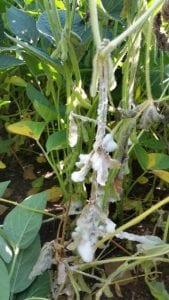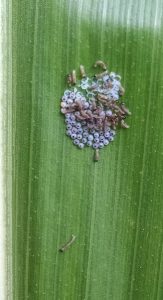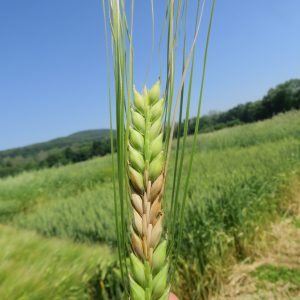NYS IPM Weekly Field Crops Pest Report: August 12, 2019
Volume 18, Number 15
View from the Field
White Mold in Soybeans (Sclerotinia sclerotiorum)
Make sure to check for white mold in soybeans. Jaime Cummings the NYS IPM Field Crops and Livestock Coordinator has prepared an article on White Mold management. The link to the article is below:
White Mold of Soybean: What to expect with variable growth stages
Western Bean Cutworm (Striacosta albicosta)
There are reports of 400 to 800 Western Bean Cutworm moths caught in single traps in Northern NY. With about 1/2 of the traps reporting, we are already at almost 7,400 moths caught this week. It will not surprise me if the number of moths will be around 10,00o to 15,000 once all of the trap reposts are entered. Egg masses and small 1st instar larvae are being found in some pretassel cornfields. Some fields are reporting above threshold levels. Remember to get out and scout for this pest.
Potato Leafhopper (Empoasca fabae)
There are continued reports of potato leafhopper (Empoasca fabae) (PLH) over threshold in several fields across NY. For information on scouting/monitoring PLH in alfalfa, view the following video:
IPM for potato leafhopper in alfalfa-Video
Fusarium Head Blight (Fusarium graminearum and other species)
Christian Malsatzki (CCE Ulster County) reports that much of the organic malting barley and wheat in the mid-Hudson Valley were tested with high levels of vomitoxin from Fusarium Head Blight. One of the most devastating diseases of small grains is Fusarium head blight. This disease infects the grain head at flowering. The pathogen builds up in corn, wheat and other grain residues. During the day, the spores are carried up into the atmosphere, and at night they settle out across the landscape. If it rains at flowering and spores are present there is a good chance the grain will become infected with the disease. Much of the grain tested for levels of the toxin that cannot be used for brewing or bread. This toxin is toxic to people and cannot be over 2 ppm in wheat or 1ppm in malting barley for used for human consumption.
Other Reports of Pest Issues
Josh Putman (CCE Southwest Dairy, Livestock and Field Crops Program) reports finding glyphosate resistant marestail in vineyards. It most likely came from a seedbank from nearby soybean fields.
Janice Degni (SCNY Dairy & Field Crops Team) reporting finding high levels of gray leaf spot and northern corn leaf blight in cornfields. Some of these fields had hail damage that may open the plants up to diseases.
Mike Hunter (CCE Northern NY) reports that glyphosate and ALS resistant marestail has been confirmed in Northern NY. Mike also reports that tall waterhemp is now confirmed in Jefferson County.
Jaime Cumming (NYS IPM Field Crops and Dairy/Livestock) reports finding low levels of frogeye leaf spot, downy mildew and brown spot in soybeans. One soybean field has been identified with moderate levels of Fusarium wilt. She also suggests that there are moderate to high levels of damage from grasshoppers and Japanese beetles in soybeans. Jaime reminds us to check for white mold in soybeans. Jaime is finding very high levels of potato leafhopper damage in hemp along with corn rootworm, lygus and false chinch bugs, low levels of foliar leaf spots and Fusarium root rot/wilt.
Weather Outlook – August 8, 2019
Jessica Spaccio
NOAA Northeast Regional Climate Center, Cornell University
Last week temperatures ranged within 2 degrees of normal. Precipitation has ranged from a hundredth of an inch to near 3 inches. Base 50 growing degree-days ranged from 70 to 170.
A cold front will bring strong to severe storms on Thursday, with cooler and dryer weather following.
Today a cold front will bring afternoon to evening showers and thunderstorms with gusty winds, hail, and heavy rain possible; temperatures in the mid-70s to 80s. Overnight lows will be in the mid-50s to low 60s.
Friday will be cooler and windy with temperatures in the 70s and isolated afternoon showers. Overnight temperatures will be in the 50s.
Saturday temperatures will be in the 70s with mostly dry conditions, a few isolated showers are possible. Overnight temperatures will be in the 50s.
Sunday will be sunny with highs in the 70s and low 80s. Overnight temperatures will be in the 50s with showers overnight.
Monday temperatures will be in the mid-70s to mid-80s with possible showers. Overnight temperatures will be in the mid-50s to low 60s.
Tuesday highs will be in the mid-70s to mid-80s. Overnight temperatures will be in the mid-50s to low 60s. Showers and thunderstorms will be possible Tuesday into Wednesday.
Wednesday highs will be in the mid-70s to mid-80s. Overnight temperatures will be in the mid-50s to low 60s.
The seven-day precipitation amounts will range from a hundredth of an inch to one and a quarter inches.
The 8-14 day outlook (August 15-21) favors near-normal temperatures for most of the state; slightly favors above-normal temperatures for southwest NY. The outlook slightly favors below-normal precipitation for all of the state.
National Weather Service watch/warnings map:
CLIMOD2 (NRCC data interface):
More Pokeweed than Usual?
Jaime Cummings and Ken Wise (NYS IPM), Jeff Miller, Mike Hunter and Paul Cerosaletti (CCE)
We are receiving reports and more questions than usual on pokeweed incidence this season from various parts of the state. Particularly with regards to it seemingly surviving glyphosate applications in fields. Some of us are familiar with this large weed, and know that once established in your fields, it can be a serious challenge to eradicate. And, sometimes by the time you notice it, it has already flowered and set fruit, and the birds are helping to spread it further.
Here are some quick questions and answers on pokeweed:
Why is pokeweed so challenging to manage? It’s a perennial with a very large and persistent taproot, and is also a prolific seed producer with a wide emergence period.
Why is pokeweed becoming more prevalent? Plowing and soil-applied residual herbicides were the typical management strategies for this weed. With the widespread adoption of no-till or conservation tillage practices, and a move away from some of those residual herbicides in combination with less crop rotation diversity, we are experiencing a resurgence of pokeweed.
Why do I still have pokeweed in my fields that were treated with glyphosate? Pokeweed seedlings can emerge from May – August, which means that you may have missed some of the later emerging seedlings during your typical early-season corn and soybean herbicide applications, especially if you didn’t include a residual herbicide in the mix. And, since pokeweed is a perennial, you may be trying to kill plants that over-wintered and have established huge and hardy taproots. It’s challenging to kill any weed with well-established taproots with a single herbicide application.
Figure 1. Research at Penn State University illustrates seasonal patterns pokeweed seedling emergence. This figure can be found as part of a larger presentation, available here.
Pokeweed seedlings can emerge continuously throughout the summer, with a peak in May and ending in August (Fig. 1). This long period of emergence makes it difficult to manage with a single-pass program of post-emergence herbicides alone. And, it’s important to manage any seedlings that emerge later in the season, because although they are unlikely to set seed that season, they can produce a serious taproot to overwinter and pop up the following year (Fig. 2). Research by K. Patches at Penn State University from 2011-2013 investigated the biology and management of pokeweed, and determined that many herbicides (including glyphosate and plant growth regulators) provided at least 80% control, when applied with either air induction or flat fan nozzles (Figs. 3 & 4). And, in those trials, glyphosate applications after mid-June provided better control than applications made earlier in the season (Fig. 5). This is because systemic herbicides applied at flowering on perennials are more likely to be translocated down to the roots to kill the taproot. For increased later season pokeweed control, consider rotating into a small grain crop and applying herbicides in August to kill the seedlings that emerged after your typical soybean or corn herbicide applications.
Figure 2. Pokeweed seedling continual emergence May-August, as observed in research at Penn State University. (Photos by K. Patches)
Figure 3. Results from Penn State research trials on herbicide efficacy against pokeweed in corn 12 weeks after application. (Figure courtesy of Penn State University)
Figure 4. Results from Penn State research trials on herbicide efficacy against pokeweed in soybean 12 weeks after application. (Figure courtesy of Penn State University)
Figure 5. Timing of glyphosate applications for controlling pokeweed in corn and soybean. (Figure courtesy of Penn State University)
Western Bean Cutworm Data
Clipboard Checklist
Keith Waldron, NYS IPM
General
*Walk fields to check general field condition, weed, vertebrate and other issues
*Watch for crop maturity, stand assessments, weed escapes, nutrient deficiencies, lodging issues
Alfalfa:
*Evaluate established legume stands for approximate days until harvest
*Monitor potato leafhopper, foliar, systemic and crown rot diseases.
*Monitor new seedings for potato leafhopper, pythium blight, phytopthora root rot.
Small Grains:
*Monitor grain fields for growth stage, disease and lodging issues, grain maturity, harvest timing
*Record diseases present, location and types of weed escapes
Corn:
*Monitor for mid-season corn pests including European corn borer, corn rootworm, western bean cutworm, slugs, foliar diseases such as northern corn leaf blight and gray leaf spot, weed issues, nutrient deficiencies, vertebrate damage.
Soybeans:
*Monitor for soybean aphid, defoliators, foliar and soilborne diseases (white mold, sudden death syndrome, Fusarium wilt, stem canker, brown stem rot) weed issues, vertebrate damage
Pastures:
*Check water sources, mend fences as needed.
*Check crop growth, clip pastures between grazing as needed
*Monitor for invasive species, plants harmful to livestock
*Review/Plan rotations
Storage:
* Check stored grain bins for temperature, moisture and signs of mold and insects. Aerate, core, transfer grain or treat as necessary
* Clean and disinfect empty storage bins in preparation for grain harvest
*Check forage allocation and anticipate feed program adjustments as forages from previous year are used up
*Mow around storage bins and facility to minimize pest hiding places
Dairy Cattle Barn Fly Management:
*Monitor animals and barn area for house fly, stable fly and other pest management needs including presence of rodents and birds.
*Check facilities for favorable fly breeding conditions: (organic matter + moisture): leaks in watering systems, roof gutters for leaks and potential overspill, drainage,
*Sanitation, sanitation, sanitation – clean animal resting areas, feed troughs, minimize source of moist organic matter i.e. fly breeding areas in barn and in adjacent animal loafing yard
* Continue fly monitoring: install “3X5″ index card fly speck monitoring cards throughout barn
*Use, replenish, replace fly management materials: sticky fly tapes/ribbons, insecticide baits, natural enemies (parasitoids), fly population monitoring (3 x 5) spot cards
*Consider purchase and release of Muscidifurax raptor and/or M. raptorellus natural enemies of house and stable fly pupae.
Dairy Cattle on Pasture:
*Monitor animals for presence of face flies, horn flies and stable flies. Action guidelines: face flies (average 10 per animal face), horn flies (average 50 / dairy per animal side, 200 / beef cattle per animal side), stable flies average 10 per animal (all four legs)
*Check feed bunk / water source locations for signs of stable fly breeding (moist undisturbed organic matter – spilled feed, round bales, etc.), minimize source of moist organic matter i.e. fly breeding areas in barn and in adjacent animal exercise yard.
*Check pasture for forage quality / quantity, rotate as appropriate
*Check pasture for vegetation poisonous to livestock
*Consider use of pasture fly traps to help reduce deer, horse and stable fly populations









